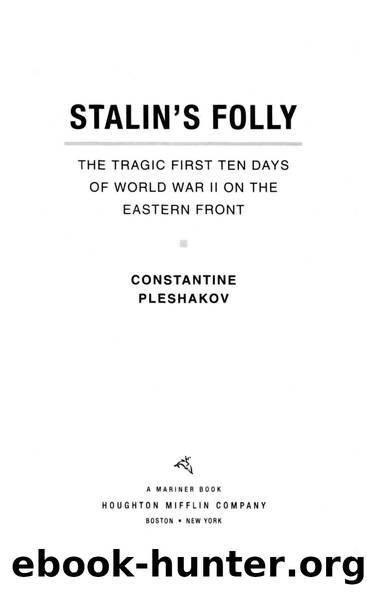Stalin's Folly by Pleshakov Constantine

Author:Pleshakov, Constantine [Pleshakov, Constantine]
Language: eng
Format: epub
Tags: History, Military, World War II, Russia & the Former Soviet Union
ISBN: 9780618773619
Google: gDhpqYwg7MgC
Publisher: Houghton Mifflin Harcourt
Published: 2006-01-15T16:20:11+00:00
General Riabyshev, Eighth Mechanized Corps, June 22â26
An avowed cavalryman, Lieutenant General Riabyshev had always trusted horses more than tanks. Only a year earlier he had been in charge of a cavalry corps. He now tried hard to like the steel monsters that he commanded.
He spent the morning of June 22 in the corpsâ compound in Drogobych, waiting for orders from the Sixth Army commander, his immediate superior. Meanwhile, the Germans kept up their ferocious bombing of the Eighth. At ten oâclock a messenger arrived: by the end of the day Riabyshevâs men were to relocate to the woods west of Sambor. Sambor lay very close to the border, which meant that they would soon be in contact with German tanks. No evacuation of civilians had been ordered, so the officers were forced to leave their families in the compound, which was now blazing but only a few hours earlier had been a secure base and a comfortable home.
The 50-mile march to Sambor proved stressful. The corps, with 30,000 men and an awkward assortment of 932 tanks, proceeded slowly. Only 169 of the eight kinds of tanks were the new KVs and T-34s. The older tanks couldnât go more than 300 miles without needing repairs, and 197 of them already had serious mechanical problems. Most of the tanks used gasolineâthree different kinds of gasolineâbut 171 had to have diesel fuel. The tanksâ guns were equally diverse: there were five models, demanding five different kinds of shells. Difficult even in peacetime, logistics were now a nightmare.
To boost morale, the commissars painted bellicose slogans on the sides of the tanks, ranging from the uninspired (âLong Live Communism!â) to the audacious (âTo Berlin!â). Soldiers who had fallen for the propaganda now asked whether the German working class had already risen against Hitler. Many said that the war would be over in a few months. Riabyshev wasnât so sure.
The Eighth soon met the first refugees. Women and children sitting on bags and bundles in the open trucks looked frightened, but at least they didnât have to flee on footâsome kind army commander had provided them with transportation. Riabyshevâs officers thought about their own families, abandoned at Drogobych, and their hearts ached. Almost every truck carried scores of wounded too. Many houses along the road had been blasted by German bombs, and several times the soldiers saw dead children lying in the rubble.
Someone in army headquarters had made a mistake, and Riabyshev soon discovered that while the Eighth was marching from Drogobych to Sambor, General N. K. Kirillovâs Thirteenth Rifle Corps was moving from Sambor to Drogobych along the same highway. The road was narrow, and the two corps had to sidle past each other. Riabyshevâs tank crews had a harder time than Kirillovâs infantrymen, because bridges collapsed under the weight of their vehicles and the heat caused the tank wheels to tear up the road, making it almost impassable for those in the rear.
Download
This site does not store any files on its server. We only index and link to content provided by other sites. Please contact the content providers to delete copyright contents if any and email us, we'll remove relevant links or contents immediately.
| Africa | Americas |
| Arctic & Antarctica | Asia |
| Australia & Oceania | Europe |
| Middle East | Russia |
| United States | World |
| Ancient Civilizations | Military |
| Historical Study & Educational Resources |
Red Famine: Stalin's War on Ukraine by Anne Applebaum(2469)
Chernobyl by Serhii Plokhy(2131)
Midnight in Chernobyl by Adam Higginbotham(2081)
The House of Government by Slezkine Yuri(1847)
Midnight in Chernobyl: The Untold Story of the World's Greatest Nuclear Disaster by Adam Higginbotham(1776)
Red Shambhala by Andrei Znamenski(1752)
The Gulag Archipelago (Vintage Classics) by Aleksandr Solzhenitsyn(1730)
From Cold War to Hot Peace by Michael McFaul(1714)
All the Kremlin's Men by Mikhail Zygar(1703)
Putin's Labyrinth(1662)
Red Notice by Bill Browder(1596)
The Future Is History by Masha Gessen(1593)
From Russia with Lunch by David Smiedt(1553)
A People's Tragedy by Orlando Figes(1545)
The Romanovs by Simon Sebag Montefiore(1492)
How to Tame a Fox (and Build a Dog): Visionary Scientists and a Siberian Tale of Jump-Started Evolution by Lee Alan Dugatkin & Lyudmila Trut(1469)
Putin's Labyrinth: Spies, Murder, and the Dark Heart of the New Russia(1457)
The Lost Spy by Andrew Meier(1399)
Art and Revolution by John Berger(1391)
